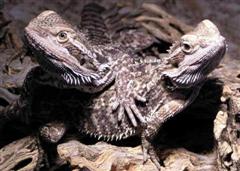Swift - Emerald
Green Spiny Lizard, Mexican Emerald Swift Scientific Name: Sceloporus malachiticus
Thu, 21st November, 2024 - 8:56 pm GMT
Sponsor Ads:

Alternative Name
Green Spiny Lizard, Mexican Emerald Swift Scientific Name: Sceloporus malachiticusBasic Info
Their body type is stocky, and they grow to about six inches in length. They are completely shrouded, head to toe, in emerald-colored scales, the color of the deep forest. Males tend to have a light blue hue to them, while females tend to be a little on the gray side, usually with brown spots.
Health
Emerald Swifts do like to burrow sometimes; providing a substrate they can burrow in, may help them feel more secure and less stressed in captivity.They should at least have hiding spots located at the cooler and warmer areas of the enclosure. They appreciate humidity, so mist the cage daily. Emerald swifts are diurnal lizards and should have full-spectrum UV lighting for about 12 hours a day. During the day the enclosure should have a basking spot that is about 90-95 degrees Fahrenheit and a cooler area of the cage that is about 80-85 degrees. At night the enclosure should be between 70 and 75 degrees. Breeding Emerald Swifts have been bred in captivity, though it is probably a bit more difficult than average to breed them and maintain the babies into adulthood. To promote breeding house two or three females with one male in a large tank. Males will fight if more than one is allowed in a tank, so it is best to keep only one male in the breeding tank. The breeding tank should be at least 50-gallons; these lizards need a lot of room because they are very active and lively. In order to promote good health and breeding they must have the right conditions. They need a lot of branches to hide in and slightly moist soil with a fair to high amount of humidity in the air. Potting soil mixed with sand works great for them. Keep the substrate slightly moist but not really wet. The branches should be large, about 7 or 8 inches in diameter or more and nearly as long as the tank. They like to sit on top of the braches to bask. A heat lamp is necessary and also UV lighting. It has been reported that they really don't like to be hot all the time. Their native environment is in forested areas set at high elevations. The nights are quite cool and humid. It is perfectly fine if their tank gets down into the low 60s (Fahrenheit). In fact, this will stimulate them to breed and will keep them healthier. They can even tolerate temperatures as low as in the 50s (Fahrenheit). Just remember they must be allowed to warm back up in the daytime either by the sun, or with their heat lamp. The female will soon become pregnant under the right conditions. You can tell this by her increased belly size. She will then one day find a place to hide out and give birth to her babies. Emerald swifts do not lay eggs, they give birth to live babies hat already able to run around and eat on their own. They usually have 2 or 3, sometimes 4 babies at a time. The youngsters are somewhat hard to feed, because they need tiny insects. Very small crickets work out okay, but fruit flies are best since they are more nutritious. Babies can be kept in the same tank with the adults without any problems, provided the tank is large enough and the adults are well fed. It also helps a lot to make sure there are plenty of hiding places for the babies, and you must make sure the humidity level stays high by misting the enclosure every day. The babies need more moisture than the parents do. It has been reported that even under ideal conditions, you will probably lose a few babies.Habitat
Live in forested areasBehavior
The Emerald Swift is a lively, and fascinating lizard. Generally docile, the Emerald Swift is a tough, wild little lizard. They generally are not as easy to handle as other lizards and are probably best kept as primarily display animals, though with gentle, consistent handling some individuals will calm down quite a bit. Surprisingly, the Emerald Swifts' life expectancy drops once they are in captivity. If you do not provide suitable conditions, they could die after less than a year in your care. When cared for properly though, people have had good luck keeping these lizards and there is no reason your experience should be any different. The aquarium should have things they can climb on, like old branches, and big rocks.Origin
Central AmericaHistory
These Swifts are native to Mexico and Panama, where they live in forested areas.Common Foods
Swifts are primarily insectivorous, but some have been known to eat small amounts of plant leaves in the wild.Sponsor Ads:
Life is a sexually transmitted disease.
Swift - Emerald
Coded by: BGID® | ALL RIGHTS RESERVED Copyright © 2000-2024
Disclaimer | Privacy | Report Errors / Contact | Credits



 Beware the new Naval power, they are planning to come on stream with big naval might to match their ground forces. Chinese Aircraft Carrier - Chinese Navy
Beware the new Naval power, they are planning to come on stream with big naval might to match their ground forces. Chinese Aircraft Carrier - Chinese Navy  versus
versus 
 versus
versus  This Thread is about the North Korean Military itself - the kind of army, navy, and air force they have.
This Thread is about the North Korean Military itself - the kind of army, navy, and air force they have. 
 versus
versus  versus
versus 
 versus
versus  versus
versus